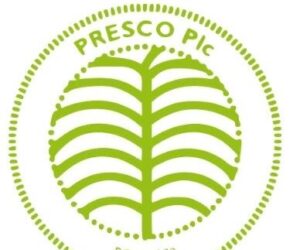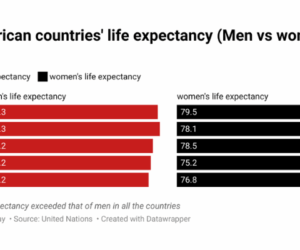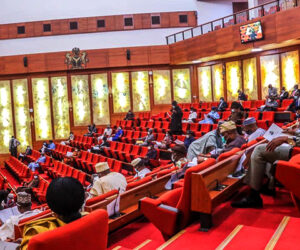…As US ban, inflation, floods, infrastructure gap hit local players
At Ikotun market on Saturday, August 16, Iya Bola – which means Bola’s mother in Yoruba- displayed her baskets of fish, attracting customers who swarmed around them like bees to honey.
“This one is Kote. A piece goes for N3,700. Titus sells at N7,000 for 1 kilo. I also have Panla, which is quite cheaper. With N3000, I can give you two,” she told a customer.
In less than three hours, Iya Bola had emptied a basket of fish and made over N300,000 in sales.
“Fish is in high demand,” she told the reporter. “I sell two or three baskets every weekend. Many people in Lagos go for Panla due to its lower price, but the rich and the middle-class buy mostly Titus,” she explained.
“Fish is good business, but you can lose money easily if you don’t have good facilities to store them.”
Read also: Nigeria seeks World Bank financing to plug problematic fish importation
From Makoko and Oluwo fish markets in Lagos to Yan Kifi in Kano and Ochanja in Onitsha, Nigerians travel far and wide in search of this readily available, rich source of protein.
There are about 33,000 species of fish today across the world. However, the commonest types in Nigeria are Kote or Horse Mackerel, Shawa (Bonga Fish), Titus, Catfish, and Tilapia.
Demand, supply data
The Central Bank of Nigeria (CBN) data say that Nigeria produces 1.07 million metric tons (mmt) of fish annually. Demand is estimated at 3.6 million tons, thereby leaving a gap of about 2.5 million tons. The gap is mainly met by imports.
Statista, an online data platform, estimates Nigeria’s fish market (including seafood) at $17.88 billion, which is N27.52 trillion. The National Bureau of Statistics (NBS) estimates local demand at N4.46 trillion. This leaves a gap of N23.06 trillion.
The literal interpretation of the data is that Nigeria’s fish market (including seafood) is estimated at N27.517 trillion, but local farmers produce only N4.46 trillion, which is just 16 percent of the market. The rest comes from imports from the Faroe Islands, Ireland, Chile, the United States, Argentina, Norway, the Netherlands and Russia, among others.
The N23 trillion opportunity
Hence, Nigeria’s fish supply gap has created a N23 trillion opportunity for entrepreneurs ready to tap into the market and build wealth.
There are 10 million Nigerians involved in fish production, but they are yet unable to meet the huge market demand.
“It is estimated that over 10 million Nigerians are actively engaged in primary and secondary fisheries operations, thus creating wealth for our people,” Mohammed Mahmood, former minister of Agriculture and Rural Development, said in 2022.
Read also: FG vows to stop fish importation, unveils plan to boost production
Smoked or fried?
Fish is in high demand in Nigeria, mostly due to its health benefits. It is healthier than meat and contains high omega-3 content, lower saturated fat levels, and can help to reduce the risk of chronic diseases.
As a result, Nigerians go for it, no matter the type.
Nationals have also devised ways of making money from it. Some smoke it, others leave it fresh or fry it. And some use it for barbecues.
At bars, Nigerians enjoy fish pepper soup, loaded with seasonings and herbs. A plate of fish pepper soup goes between N2,000 and N10,000.
“I make more than N150,000 every day,” Haruna Babangida, a barbecue seller in Kubwa, Abuja, told the reporter.
“I start my business at 6pm every day and close around 12am. People come from Dei Dei to buy from me.”
The smoked fish market is also huge and is estimated at over $150 million. IndexBox says the market declined by 32 percent in 2024 owing to a falling demand.
Fish export
Nigeria exports fish. The nation exported fish, crustaceans, molluscs, and aquatic invertebrates worth $54 million in 2024, according to NBS data.
Some of the firms exporting fish from Nigeria to the rest of the world are Atlantic Shrimpers Limited, ORC Fishing and Food Processing, Banarly Nigeria Limited, Karflex Fisheries, Seagold Fisheries, Sole Agro, Amex Fishing, Daril Tweens Nigeria, Paramount Frozen, among others.
Fish is often smoked, dried and properly packaged before export.
Read also: Lagos bets big on N10bn aquaculture centre to boost fish production
Little cheer for local players
However, it is not all uhuru for the fish market.
Local producers are hard hit by high inflation in Nigeria, which has shot up the cost of feed. The industry is stymied by an infrastructure gap and poor agro practices.
In 2024, Cheta Nwanze, partner at SBM Intelligence, said: “Improving Nigeria’s fishing industry must begin by declaring a state of emergency in that sector.”
According to Nwanze, the sector is being hampered by a myriad of challenges ranging from infrastructural gaps to lack of exposure of fish farmers to modern aquaculture practices, poor quality feed, pests, diseases, and climate change effects such as flooding, among others.
“These have consequently made fish production levels in the country unable to meet growing local demand, and the sector unattractive.”
Also, floods are wreaking havoc in several fish farms across Nigeria.
In March 2018, the United States government banned fish imports from Nigeria on the back of insufficient documentation within the required time frame.
Read also: Food security: Oyetola charts new direction to improve local fish production, livelihood
Remi Ahmed, national president of the Tilapia and Aquaculture Developers Association of Nigeria, said in 2024 that the market is contracting for Nigeria’s fish products owing to the high costs, preference for imported fish, and the ban on the nation’s catfish exports.
Temitayo Odukoya, an Ibadan-based fish farmer, who farms Tilapia and catfish, said the cost of petrol, feed and staffing are major challenges.
“When you are managing anything that is alive, you need to treat it like a human being. This means fish is costly to maintain. But it is important to learn modern practices to save costs. Otherwise, one disease can be very costly.”









